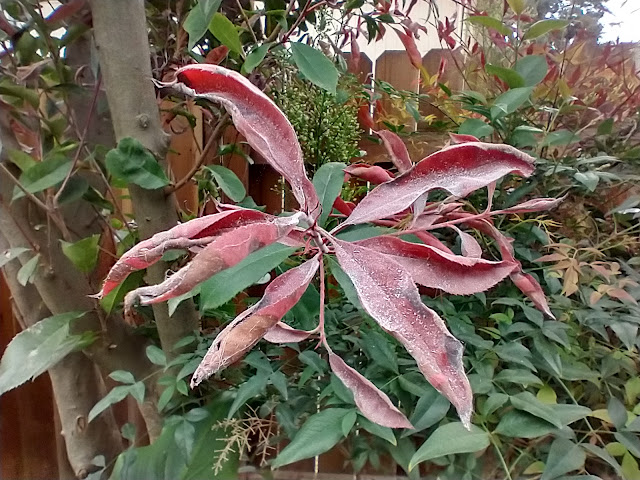
|
|
This photinia is plastered with powdery mildew. Trim off infected foliage to try and curb its spread. (Photo: Debbie Arrington)
|
Spring seemed to arrive early this year – and so did the powdery mildew.
This fungal disease looks like fairies dusted leaves and emerging buds with powdered sugar. But there’s nothing sweet about this fungus. It clogs the leaves’ pores and eventually kills the foliage. Infected foliage drops off, leaving the plant susceptible to sunburn.
Like other fungal diseases, it’s triggered by temperature. Once we hit pleasant afternoon temperatures around 70 degrees, powdery mildew literally explodes. The spore factories, located on the underside of leaves, pop open and blast their white dust on nearby foliage and plants.
Those spores are easily carried by the breeze to other susceptible plants, spreading the infection throughout your garden – and the neighborhood. It particularly likes roses but also can infect crape myrtle and sycamore trees, plus azaleas, rhododendrons, begonias, mums, dahlias, sunflowers, coral bells, calendulas and zinnias as well as many other ornamentals such as photinia. It can be problematic on apple and peach trees as well as raspberry vines. In the vegetable garden, it attacks the foliage on melons, pumpkins, squash, cucumbers, beans and peas.
Although it’s a mildew, powdery mildew doesn’t need wet conditions to multiply. In fact, rain (or overhead sprinklers) can stop an outbreak.
Powdery mildew particularly likes plants growing in partial shade or next to a wall or fence. Those factors keep air temperature cool and just the way this fungus likes it. Walls and fences also cut down on air circulation, allowing powdery mildew to thrive undisturbed.
Once you see the telltale white fungus, it’s too late; the spores have already launched their attack. But you can minimize their spread. Clip off infected plant material, bag it up and dispose of it in the trash.
Sulfur sprays or powders are only effective if applied BEFORE the disease appears. Neem oil may help contain an outbreak, but only if applied in the very earliest stages.
Two other tricks are more effective, easier and cheaper:
-- Plain water works wonders against powdery mildew. Keep the plant (and the soil beneath it) well watered. Water on leaves inhibits the fungi’s germination and kills spores.
To knock off spores before they “sugar coat” your roses, give your plants a shower. Sprinkle water on the foliage from above, preferably in the morning. That gives the plant plenty of time to dry so the leaves don’t stay wet (and cause other fungal problems).
-- Inspect your susceptible plants regularly (daily if possible) and be on the look out for puckered or deformed leaves. Before releasing its white powdery spores, this fungus creates a spore-generating fruiting body, usually on the underside of a leaf. As it sucks energy from the leaf, the spore factory deforms its host. When it’s ready, it releases the telltale white spores all over that leaf and neighboring foliage.
Don’t wait; clip that puckered leaf off the plant and dispose of it before it can spread spores everywhere.
The good news: Powdery mildew doesn’t stick around in high heat. It can’t stand temperatures above 90 degrees; 95 degrees pretty much wipes it out. Damaged foliage will fall off to be replaced by healthy leaves.
For more tips, check out the UC Integrated Pest Management pest notes on powdery mildew:
http://ipm.ucanr.edu/PMG/PESTNOTES/pn7493.html

